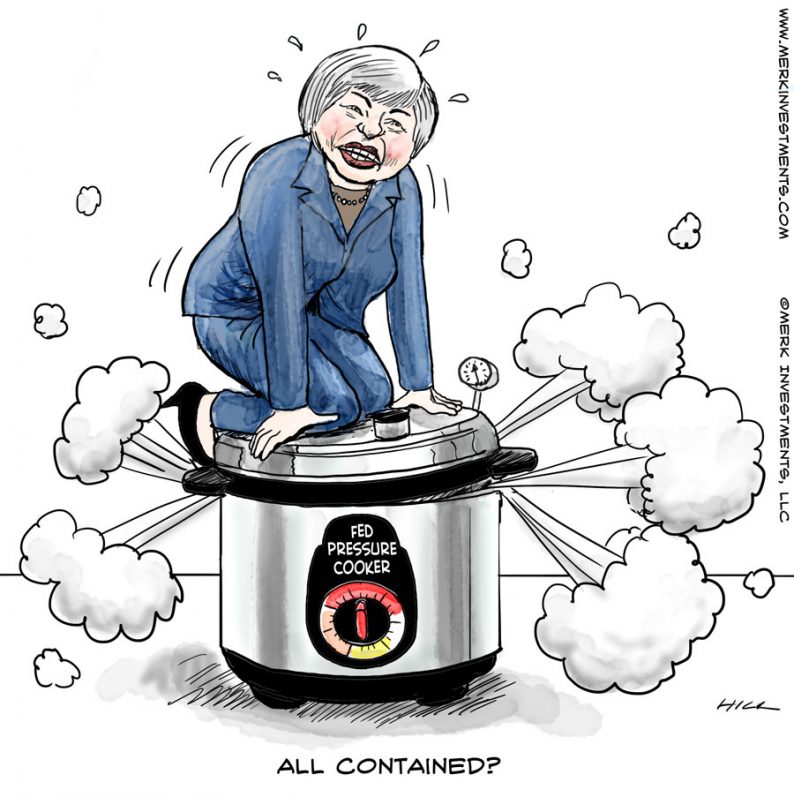With seemingly everyone from the blogosphere to the Tweeter-in-chief chiming in on fake news, have investors considered their risk/return profile may also be “fake”? When it comes to investing, who or what can we trust, is the market rigged, and why does it matter?

For eight years in a row now, an investment in the S&P 500 has yielded positive returns.1 In recent years, expressions like “investors buy the dips” and “low volatility” have become associated with this rally.
In the “old days”, investors used to construct portfolios that, at least in theory, provided a risk/return profile that they were comfortable with. For better or worse, I allege those “old days” are over. To be prepared for what’s ahead, let’s debunk some myths.
The system is rigged
For those that say the system is rigged, I concur. In my assessment, central banks are largely responsible for a compression of “risk premia.” All else equal, quantitative easing and its variants around the globe have made assets from equities to bonds appear less risky than they are. This is at the very core of central banks efforts to entice investors to take risks, as risk taking is key to making an economy grow. In practice, central banks have foremost pushed up financial assets, but have largely disappointed in generating real investments. As a result, those holding financial assets have disproportionally benefited.
Hidden risks: liquidity
When I look at market risks, I feel like investors are in ‘la la land,’ ignoring the moonlight. Pardon the pun, I believe investors completely underappreciate hidden risks in the markets, notably the risk of liquidity evaporating. In today’s ETF driven world, to make ETFs track underlying indices, there are so-called market makers providing liquidity. Exchanges are providing incentives to these market makers; ever look at those exchange fees on your trade ticket? The exchange pays market makers from these fees for each share they buy or sell (ranging from fractions of a cent to multiple cents); such a “rebate” gives market makers a better price than you can possibly get, so they can cost effectively hedge their own risk, thus incentivizing them to provide liquidity. Each ETF has a so-called lead market maker that, by arrangement, gets a better deal than the other market makers. Through that, all the other market makers know they can always offload their risk to the lead market maker. Everyone is happy, including the investor. Except when the lead market maker has a glitch. Suddenly, just about everyone withdraws liquidity because something appears wrong. In addition, Dodd Frank discourages traditional market makers to provide liquidity. Flash crashes can then occur when investors place market orders in the wrong belief that the system will take care of them. As a result, in our opinion, the current design of the system makes the periodic flash crash a near certainty.
Risk is merely masked
In the past, I have compared central bank efforts to suppress risk akin to putting a lid on a pressure cooker. It should come as no surprise that taking the lid off might cause a spike a volatility, e.g., a taper tantrum. In the meantime, while the European Central Bank (ECB) and Bank of Japan (BoJ) are still ‘printing money’, the Fed is trying to raise rates.
Investors desperate for insurance?
We talk to a lot of investors who go along for the ride as the market is rising, but are rather concerned the party could come to an end. Instead of rebalancing their portfolios or taking chips off the table, however, they are looking for ways to have their cake and eat it too by buying insurance. One way to buy insurance on equities is to buy put options on equities. Another is to buy volatility, i.e. take a speculative position that volatility in the market is going to rise. Through ETFs, such strategies are available to retail investors. It turns out that buying insurance can be very expensive (at times more than 10% a month in case of buying volatility), making this not a prudent long-term investment. As with anything else in this analysis, we are observing what we see in the market, we not making an investment recommendation.
Selling volatility: a risky proposition?
It wouldn’t be Wall Street, if there weren’t investors on the other side of the trade of those trying to buy insurance: selling volatility has become a very fashionable trade. The idea is that so long as volatility stays low, one collects the equivalent of an insurance premium; when volatility surges, one loses money, those writing insurance might believe that those surges and associated losses are always temporary (buy the dips, remember!); over the medium term, so the logic goes, such a strategy promises to be profitable. To be clear: we do not recommend investors pursue this strategy even as such strategies have become increasingly popular. Amongst others, a single mutual fund pursuing a strategy building on that concept had amassed over four billion in assets. After all, what could possibly go wrong? What has gone wrong is that a few weeks ago, the fund experienced substantial loses in the absence of a surge in volatility. What appears to have happened is that a too-good-to-be-true strategy became victim of its own success. In our analysis, the fund encountered a particular constellation where their derivatives position was inherently difficult to manage, with difficulties exacerbated because of their size. Differently said, they were cornered. More than a few investors appear to have concluded that they didn’t sign up for the risks that materialized and have withdrawn their investments.













Leave A Comment